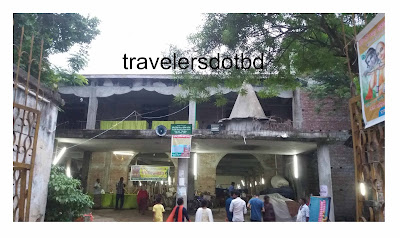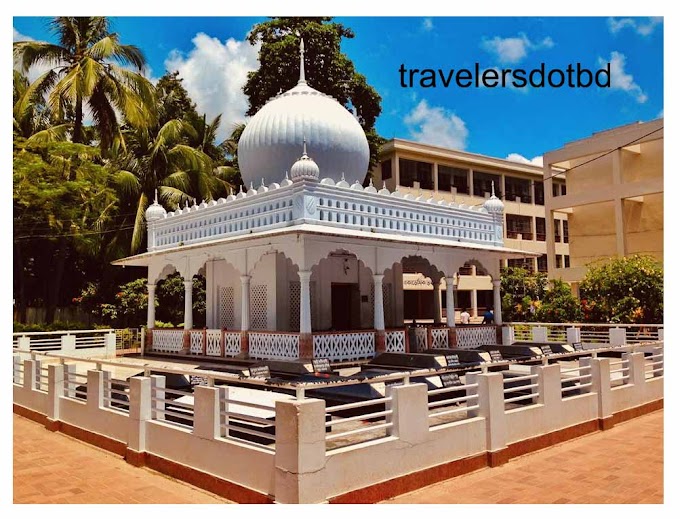Gopinath Ji Temple
 |
| Gopinath Ji Temple |
The Gopinath Ji Temple, built about 500 years ago, is an example of ancient architecture commemorating Isha Khan, one of the heroes of the Bar Bhuiyans of Bengal. The temple is located in Achmita Bhog Betal area, three kilometers north of Katiadi Upazila Sadar in Kishoreganj. If the Gopinath Ji Temple is renovated, it could become an aesthetic tourist destination in the region.
This ancient temple was built by the feudal lord Nabarang Roy in 1575 during the reign of Mughal Emperor Akbar. Kutaman Dighi, located to the south of Gopinath Ji Temple, also stands as a memorial to King Nabarang Roy. This large reservoir of about 30 acres has added to the attraction of this ancient temple. In terms of architecture, the Gopinath Ji Temple bears a resemblance to the ancient temples of the Indian state of Orissa. Numerous tourists flock here every year to visit this temple.
There are various rumors about the history of Gopinath Ji Temple. According to some, Raja Nabarang Roy dreamed of building this temple. According to some sources, the construction of the temple was started by the pious king Navrang Roy at the behest of a devotee Pagal Baul, who was sitting under an ancient large banyan tree on the site of the temple. It is also known that Raja Navrang Roy was a devoted devotee of that saint Pagal Baul. At that time Raja Navarang Roy spent a lot of money on the construction of this temple.
Legend has it that when the construction of the temple was completed, a Baul suddenly jumped into a low swamp on the north side of the temple and disappeared. Then that crazy Baul could not be found anywhere else. Due to this legend, the wetland to the north of the temple is still known as Baul Sagar in the area. At present the area of the temple is 25 acres 6 percent. It is said that Isha Khan, one of the Bar Bhuiyans of Bengal, on his way from his then fort of Egarasindu to Jangalbari through the area adjacent to the temple, stopped at the temple to the melody of Bhog Aarti. During this time he donated a lot of land for the development of the temple. The temple on the west side had a nameplate inscribed in white stone in French on the west side of the temple as a token of his devotion. The next time the miscreants stole it.
In 1589, the Mughal emperor Akbar appointed Raja Mansingh as subedar of Bengal. At this time, due to the independence-minded attitude of Ala Isha Khan, one of the masons of Bar Bhuiyan in Bengal, Raja Mansingh attacked the fort of Egarasindu of Isha Khan on the orders of Emperor Akbar. In this battle Raja Mansingh along with the Mughal forces was defeated by Isha Khan. The biggest victory of Isha Khan's victory was celebrated at the Gopinath Jiur Rath Mela. A large number of people from different parts of Bangladesh used to gather at this temple on the occasion of Rath Yatra Mela. Large boats and barges came from the haor areas. The procession of innumerable passenger boats and barges, the tax of innumerable boats and barges, the noise of the pilgrims with the sound of the call and the sound of the women, this green forest of the secluded countryside would become an indescribable joy.
At present the various buildings of the temple are being demolished day by day. A dilapidated bridge is at the entrance to the Gopinath temple which is designed in the city of Panam. Besides, there are Dolmancha, Adi Mandir, Main Mandir, Jhulan Mandir, Gundicha Mandir and 3 big ponds.
The largest rath yatra in East Bengal was held at the Gopinath Ji temple for the first time. The temple was also one of the most important pilgrimage sites for Hindus in Bangladesh. Almost all Hindu rituals were held here regularly. Rath Yatra, Dol Purnima, Ras Purnima, Jhulan Jatra, Janmashtami, Poush Sankranti etc. are held here. The biggest event was the Rath Yatra fair. At one time it was located after the Rath Yatra of Jagannath Deva in Puri, Orissa, India. There is still a proverb, 'Jagannath of Puri is Gopinath of Bengal'.
But this traditional temple stands as a witness of the future, even though it did not have the splendor of the past. The temple is being managed by a trust committee to keep the temple afloat on the way to being lost.



0 Comments